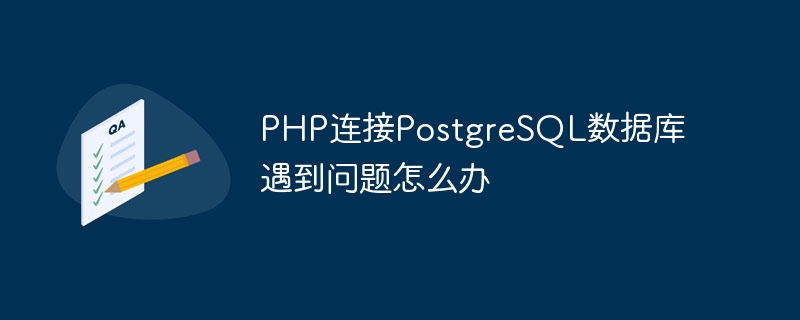 Backend Development
Backend Development
 PHP Tutorial
PHP Tutorial
 What to do if PHP encounters problems connecting to PostgreSQL database
What to do if PHP encounters problems connecting to PostgreSQL database
What to do if PHP encounters problems connecting to PostgreSQL database

What to do if PHP encounters problems connecting to the PostgreSQL database
During the development process, using PHP to connect to the PostgreSQL database is a common operation. However, sometimes various problems may be encountered during the connection process, such as connection failure, inability to execute queries, etc. This article will introduce some common problems and solutions, and provide specific code examples to help readers better deal with these problems.
Problem 1: Failed to connect to the database
When trying to connect to the PostgreSQL database, sometimes the connection fails. This may be due to incorrect server configuration, incorrect database credentials, etc. Here is a way to handle connection failure:
<?php
$host = "localhost";
$port = "5432";
$dbname = "mydatabase";
$user = "myuser";
$password = "mypassword";
$conn = pg_connect("host=".$host." port=".$port." dbname=".$dbname." user=".$user." password=".$password);
if(!$conn) {
echo "无法连接数据库:".pg_last_error();
} else {
echo "成功连接到数据库";
}
?>In the above code, we are trying to connect to the database named "mydatabase". If the connection fails, an error message will be output; if the connection is successful, "Successfully connected to the database" will be output.
Question 2: Error when querying data
Sometimes you will encounter syntax errors, table non-existence and other problems when executing queries. Here is a way to handle query errors:
<?php
$host = "localhost";
$port = "5432";
$dbname = "mydatabase";
$user = "myuser";
$password = "mypassword";
$conn = pg_connect("host=".$host." port=".$port." dbname=".$dbname." user=".$user." password=".$password);
if(!$conn) {
echo "无法连接数据库:".pg_last_error();
} else {
$query = "SELECT * FROM non_existent_table";
$result = pg_query($conn, $query);
if(!$result) {
echo "查询出错:".pg_last_error();
} else {
while($row = pg_fetch_assoc($result)) {
// 处理查询结果
}
}
}
?>In the above code, we try to query a non-existent table "non_existent_table". If there is an error in the query, error information will be output; if the query is successful, the query results will be traversed.
Summary
When using PHP to connect to a PostgreSQL database, you first need to ensure that the server configuration is correct and the database credentials are correct, and you must pay attention to handling connection failures and query errors. The above are solutions to some common problems, I hope it will be helpful to readers during the development process.
The above is the detailed content of What to do if PHP encounters problems connecting to PostgreSQL database. For more information, please follow other related articles on the PHP Chinese website!

Hot AI Tools

Undresser.AI Undress
AI-powered app for creating realistic nude photos

AI Clothes Remover
Online AI tool for removing clothes from photos.

Undress AI Tool
Undress images for free

Clothoff.io
AI clothes remover

AI Hentai Generator
Generate AI Hentai for free.

Hot Article

Hot Tools

Notepad++7.3.1
Easy-to-use and free code editor

SublimeText3 Chinese version
Chinese version, very easy to use

Zend Studio 13.0.1
Powerful PHP integrated development environment

Dreamweaver CS6
Visual web development tools

SublimeText3 Mac version
God-level code editing software (SublimeText3)

Hot Topics
 1358
1358
 52
52
 1196
1196
 24
24
 CakePHP Project Configuration
Sep 10, 2024 pm 05:25 PM
CakePHP Project Configuration
Sep 10, 2024 pm 05:25 PM
In this chapter, we will understand the Environment Variables, General Configuration, Database Configuration and Email Configuration in CakePHP.
 PHP 8.4 Installation and Upgrade guide for Ubuntu and Debian
Dec 24, 2024 pm 04:42 PM
PHP 8.4 Installation and Upgrade guide for Ubuntu and Debian
Dec 24, 2024 pm 04:42 PM
PHP 8.4 brings several new features, security improvements, and performance improvements with healthy amounts of feature deprecations and removals. This guide explains how to install PHP 8.4 or upgrade to PHP 8.4 on Ubuntu, Debian, or their derivati
 CakePHP Date and Time
Sep 10, 2024 pm 05:27 PM
CakePHP Date and Time
Sep 10, 2024 pm 05:27 PM
To work with date and time in cakephp4, we are going to make use of the available FrozenTime class.
 CakePHP File upload
Sep 10, 2024 pm 05:27 PM
CakePHP File upload
Sep 10, 2024 pm 05:27 PM
To work on file upload we are going to use the form helper. Here, is an example for file upload.
 CakePHP Routing
Sep 10, 2024 pm 05:25 PM
CakePHP Routing
Sep 10, 2024 pm 05:25 PM
In this chapter, we are going to learn the following topics related to routing ?
 Discuss CakePHP
Sep 10, 2024 pm 05:28 PM
Discuss CakePHP
Sep 10, 2024 pm 05:28 PM
CakePHP is an open-source framework for PHP. It is intended to make developing, deploying and maintaining applications much easier. CakePHP is based on a MVC-like architecture that is both powerful and easy to grasp. Models, Views, and Controllers gu
 CakePHP Working with Database
Sep 10, 2024 pm 05:25 PM
CakePHP Working with Database
Sep 10, 2024 pm 05:25 PM
Working with database in CakePHP is very easy. We will understand the CRUD (Create, Read, Update, Delete) operations in this chapter.
 CakePHP Creating Validators
Sep 10, 2024 pm 05:26 PM
CakePHP Creating Validators
Sep 10, 2024 pm 05:26 PM
Validator can be created by adding the following two lines in the controller.



